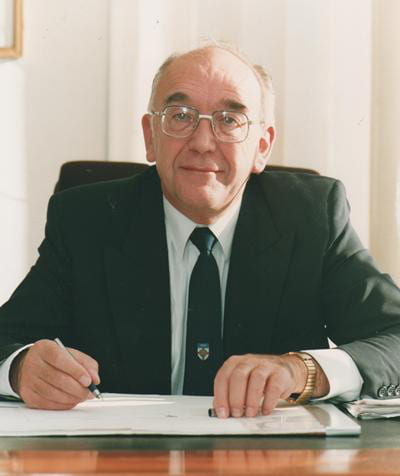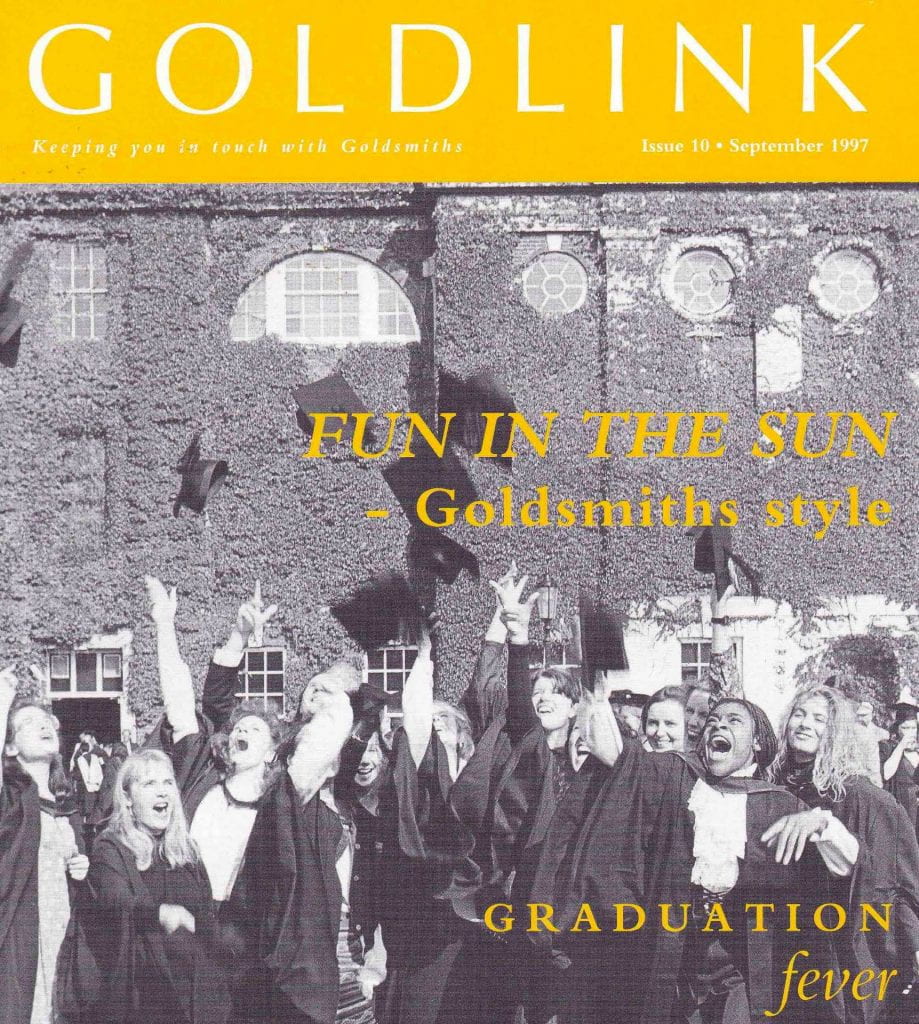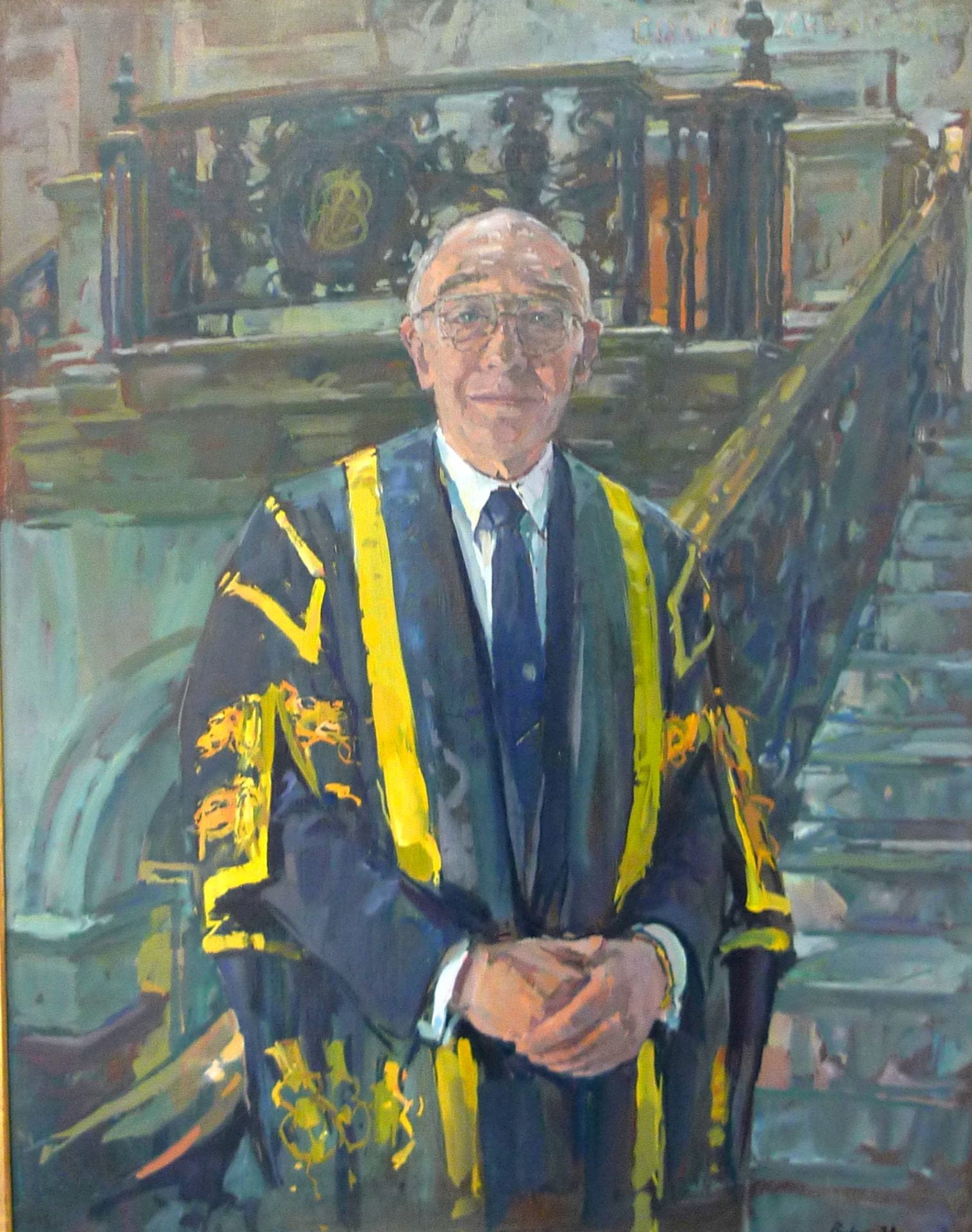
Professor Ken Gregory when Warden of Goldsmiths, University of London and wearing a Goldsmiths’ tie. Image: Goldsmiths, University of London
The ninth Warden of Goldsmiths between 1992 and 1998, Professor Ken Gregory, has passed away at the age of 82. University historian Professor Tim Crook provides an obituary and assesses his contribution to Goldsmiths.
Arriving at Goldsmiths- a distinguished Geographer with a beard and without a Geography department
Ken Gregory was 54 years old and one of the country’s most distinguished academic geographers when he came to work in New Cross from the University of Southampton where he had been Deputy Vice-Chancellor. Southampton named a lecture series after him, which has run since 1993 within the School of Geography and Environmental Science.
When he arrived at Goldsmiths he was Ken Gregory BSc, PhD, DSc and FRGS. When he died on 23rd November there were many more honours to add to his profile: CBE, DSc (Hon), DUniv, C.Geog, FGCL, and FBSG.
Ken was the Warden during six turbulent and dramatic years for universities during the 1990s. He was calm, collegiate and effective in changing the university’s direction and strengthening its stability and viability in an increasingly market driven economy.

‘Fun In The Sun- Goldsmiths style’- students celebrating graduation during Professor Ken Gregory’s time as Warden.
He arrived in the year of Prime Minister John Major’s Conservative Party victory in the General Election of 1992, when Diana, Princess of Wales secretly collaborated with Andrew Morton on the book Diana: Her True Story in Her Own Words and Linford Christie won Olympic Gold in the 100 metres at Barcelona.
Irish Republican terrorism had also devastated the City of London with a car bomb killing three people.
Within the first month of his appointment he told students and staff he was attracted to Goldsmiths ‘because of its mission, its unique mix of strengths, and the potential this offers to develop in its own distinctive way in the new diverse university system.’
From the word go he was ‘impressed by the quality of the staff […] and their ideas and imagination.’
Professor Gregory won friends and affection because he was not prone to exercise the imperative and ego of his own academic discipline. Goldsmiths had shut down its own Geography department and Geology teaching some years before.
It was ironic that Ken had even been the Geography department’s external examiner during the 1980s.
Somebody with a PhD on the geomorphology of the North York Moors was not inclined to restructure the academic ground of a small university that needed to play to its strengths; particularly in arts and humanities.
What did Ken do for Goldsmiths and Goldsmiths do for him? Some recall that he arrived with a beard and left without one, but his impact was undoubtedly substantial and improving.
Like all Wardens he did the rounds of consultation with staff, departments and students and he was certainly somebody prepared to listen. At first, he was beginning to feel that if he had a vision it was to preserve Goldsmiths’ distinctiveness and ‘pay some attention to improving the way we are perceived – for instance, through our performance in league tables, to think of a topical example.’
How had he changed Goldsmiths by 1998?
On his departure in 1998, there is no doubt he had led a substantial improvement in Goldsmiths’ research ratings which at that time meant an increase in funding when there were caps on student recruitment.
As a result, the University attracted higher quality research and teaching academics and the publication profile and public and media impact of staff achievements increased Goldsmiths’ appeal to the vital and expanding overseas market in students; particularly from China, India and other parts of Asia.
1998 was the year when New Labour under Prime Minister Tony Blair completed its first year of government, the Good Friday Agreement brought about peace to Northern Ireland, and the aftermath of the death of Diana, Princess of Wales in the car crash in Paris the year before was still being felt.
The Revd Dr Peter Galloway as Chairman of the Goldsmiths Society said ‘His achievements have been impressive, not least in building up reserves, and in the construction of the Rutherford Information Services Building.’

Warden Ken Gregory with the Princess Royal and opening the Rutherford Information Service Building in 1998- named after the Warden Ken succeeded.
His most singular impact had been to make Goldsmiths ‘research intensive’ in the academic sphere.
At the end of his six year tenure, Goldsmiths had appointed its first Black Professor, Paul Gilroy, from the department of Sociology in 1997. Other professors appointed during Ken Gregory’s time as Warden included Nikolas Rose, Windy Dryden, Alan Downie, Andrew Louth, Frances Heidensohn, Michael Craig-Martin, Peter Dickinson, Michael Musgrove, Peter Smith, and Roger Slee. All of their inaugural lectures were published by Goldsmiths as pamphlets.

Warden Ken Gregory increased the number of professorial appointments, and they included Goldsmiths’ first Black Professor Paul Gilroy in 1997. Inaugural lectures were also given extra prestige with publication in pamphlet form.
The Laurie Grove baths complex had been acquired from Lewisham Council and converted into art studios. Goldsmiths had also taken over and began to use Deptford old Town Hall.
Ken said it had been a privilege to have been Warden and he was very happy to ‘hand over a thriving, vibrant academic institution.’
He retained his affection and admiration for Goldsmiths after his retirement and said he believed it continued to reach and achieve ‘new heights’ in the years following. He would be a quiet and supportive counsel for the following Wardens if they felt they needed it.
What he said during his archive interview for Goldsmiths History Project in 2017
He very kindly recorded several hours of archive interview for the Goldsmiths history project on a bright and warm summer’s day in 2017. He recalled how being Warden was not like being the Admiral of a ship or a chief executive of a private company.
It was more of a case of leading by persuasion. He recalled that the bigger vision would sometimes mean his aims may not have been popular in some quarters. Putting pressure on all staff to be strongly research active was stressful. Shutting down some courses and subjects courted protest.
He remembered with great affection how the department of Ceramics made him a tombstone to symbolise the death of a longstanding art and craft subject.

The report in Goldlink on Ken Gregory’s retirement dinner in 1998. It highlights that he had increased the number of Goldsmiths Professors from 13 to 46. He arrived with a financial deficit and left with reserves of £2 million.
The Goldsmiths community was always one where debates and arguments would run and have a passionate and activist edge. There was a celebrated occasion when he had to back down on a student union protest against increases in cafeteria and canteen prices.
The Union simply used its own funds to buy food and cook meals for students that they could afford. During his time as Warden he encouraged and implemented the introduction of student evaluation, a need that had arisen following the introduction of Departmental Reviews.
During his time, Ken Gregory originated the Warden’s Advisory Group; otherwise known as WAG which meant he was in more direct and close contact with heads of department. This came about through his canvassing of views, opinions and aspirations from academic and support staff for whom he always retained great respect.
During the archive interview he emphasised ‘the coherence and high quality of Goldsmiths staff.’ He said as a result of listening to their views: ‘We removed Faculties and created WAG, which I always found to be a very good forum for discussion.’
Assessing Warden Gregory’s legacy
It is important to recognise and confirm the legacy that Professor Ken Gregory left for Goldsmiths during the six years of his tenure.
Like with most Wardens the primary objective was survival. Goldsmiths had to survive in 1992-93 despite the deep cuts to Higher Education and it had to develop a strategy that was research intensive.

Warden Ken Gregory presided over graduation ceremonies held in the Great Hall of what is now the Richard Hoggart main building. Many famous people received honorary fellowships including Dame Mary Quant, the author P.D. James and cockney actor Sir Michael Caine who also did a special workshop with the Drama students in the George Wood Theatre.
He created a management structure that was consultative through reorganisation and removal of Faculties. He introduced assessment of departmental academic performance otherwise known as ADAP. He persuaded the Princess Royal (Princess Anne) as Chancellor of the University of London to preside at a degree ceremony and this was subsequently copied by other University of London colleges.

An example of Ken Gregory’s style of communicating to staff, students and alumni. In this Goldlink magazine for 1998, it demonstrates his leadership on increasing Goldsmiths as a research intensive university.
He convinced the University of London of methods of promotion and advancement that applied to Goldsmiths’ disciplines, and were not inhibited by the physical sciences model. As a result, Goldsmiths could promote Professorial Chairs acknowledging practice subjects such as Music and Media and Communications. Ivor Gabor was appointed the first Professor of Broadcast Journalism in the University of London.
Ken Gregory enhanced the formal link established with the Goldsmiths Company by having the Company’s Clerk to be an ex officio member of Goldsmiths College Council. While in New Cross Professor Gregory led the introduction of a financial allocation model of management which emphasised research intensive culture. And once research funding was improved, Goldsmiths was able to recruit significant new staff in its specialist subject areas.
Fundamentally Goldsmiths’ College stopped being known as the Art School and Training College for teachers. He strongly developed its new identity as Goldsmiths University of London despite some internal administrative resistance. This avoided the cost of external consultants and has subsequently been followed by Queen Mary University of London, Royal Holloway and others.
During my interview with Ken he remembered that his biggest challenge as Warden was coping with the lack of ample funding and the security and flexibility of strong financial reserves which he did his best to build over six years.
He and his wife Chris managed to develop social events despite the lack of money.
They became famous for their receptions and dinners at the suburban Warden’s house in Ulundi Road ‘where Chris cooked and I went to Majestic for the wine. We even did dinners after inaugural lectures this way.’
Ken Gregory also fondly remembered the opportunity of meeting remarkable, interesting and famous people in his role as Warden. These included the politician and local MP Joan Ruddock, the author P.D. James, the theatre director Richard Eyre, the actress Frances de la Tour, actor Sir Michael Caine, the legendary fashion designer and entrepreneur Dame Mary Quant, and the linguist and English academic Randolph (Lord) Quirk.
Ken Gregory (1938 to 2020), Warden of Goldsmiths, University of London between 1992 and 1998.
Professor Alan Downie and the College Orator, who worked closely with Warden Ken Gregory during his time at Goldsmiths in the 1990s writes:
How a hydrologist helped transform Goldsmiths
As well as being Warden, Ken Gregory enjoyed an international reputation as a hydrologist.
He took over from Professor Andrew Rutherford at a crucial moment in Goldsmiths’ recent history. Although the College had secured school status in 1988, as a consequence of its previous status as an Institute with Recognised Teachers it had not been permitted to accumulate reserves. Further, it came bottom in the 1989 Research Assessment Exercise. Ken set about investing in research and in quality assurance. (He had been the QA DVC at Southampton.)
As a consequence of his policies and his leadership, in 1996 Goldsmiths was described in the THES as ‘a rising star’ of the RAE, and the significant further improvement in the 2001 RAE was also largely a result of Ken’s research strategy. By the time he stepped down as Warden in 1998, he had also managed to build up small but important reserves, partly as a consequence of a large increase in student numbers, not only undergraduates, but also postgraduate and overseas students.
Warden in a patterned cardigan
Ken was a congenial man who inspired immense loyalty, especially among his closest colleagues—his Deans (when there were faculties), his Pro-Wardens, and his Professors.
With his wife, Chris, doing the cooking, Ken famously hosted regular dinners at the Warden’s residence in Ulundi Road, always unsuited and casual (a patterned cardigan), ensuring his guests never ran out of drinks as he kept topping them up by his own hand. (The Gregorys refused to use caterers.)
These dinners were not restricted to senior members of the College. Over the six years of his Wardenship, there can scarcely have been a member of the academic or administrative staff who had not been invited to dinner at Ulundi Road.
Had it not been for Ken Gregory’s Wardenship, Goldsmiths would be unrecognisable as the research institution it is today.

Painted portrait of Goldsmiths’ ninth Warden Professor Ken Gregory in College robes and at the foot of the stairs of Deptford Town Hall. Image: Copyright Goldsmiths, University of London
Forthcoming ‘That’s So Goldsmiths’- an investigative history of Goldsmiths, University of London by Professor Tim Crook.